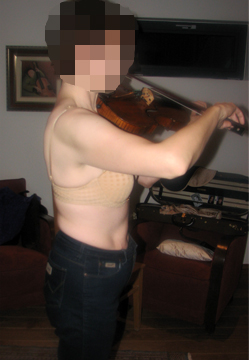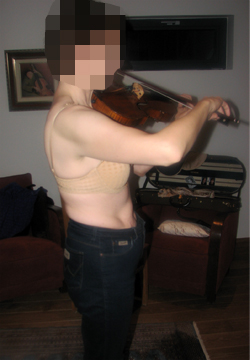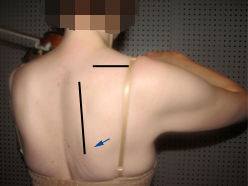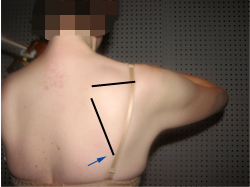Altfiol - harjoittelu
Altfiol
Läs först avsnittet Allmänt om ergonomi.
Altviolinistens bäcken och ryggrad ska vara i mittställning men ändå möjliggöra fri rörelse under spelandet. Rörelsen börjar och slutar i mittställning. Mittställningen är alltså musikerns grundställning, till vilken musikern alltid återkommer. I mittställningen upprätthålls ryggradens naturliga bågform. Ryggradens böjning är individuell, så i mittställning har alla olika ställning på ryggrad och bäcken.
Samma regler som gäller då man spelar fiol gäller i hög grad även altviolinisterna. Eftersom altfiolen är större, är det tyngre att hålla upp instrumentet, vilket i sin tur ställer större krav på ryggens sträckarmuskler samt skulderbladets stödmuskler.
|
Bäckenet och ryggraden i mittställning. |
Bäckenet framme (post tilt), ländryggraden uträtad, bröstryggen bakåtlutande.
|
Altfiolsspelande utsätter kroppen för vridning, särskilt om musikern är kortväxt. Ställningen vrids åt höger om/när det är svårt att nå stråkens spets. En statiskt vriden spelställning bör alltid korrigeras då det är möjligt. En ställning där altviolinisten samtidigt vrider sig och lutar åt vänster är mer sällsynt. Orsaken till denna felställning är brister i kroppens och skulderbladmusklernas funktion då man håller upp instrumentet.
Det är krävande att bevara stödet av stråkhandens skulderblad då man spelar med stråkspetsen, särskilt om armen måste sträckas ut i extremläge. Stödmuskulaturen borde stöda skulderbladet så att skulderbladet inte börjar luta framåt och nedåt (skuldran sjunker) då man spelar med stråkspetsen.
|
Stråkhandens lyftrörelse där skulderbladets stöd är dåligt. Skulderbladet sjunker, lutar framåt och skulderbladets nedre hörn roterar inte tillräckligt utåt. |
Stråkhandens lyftrörelse där skulderbladet stöds väl mot bröstkorgen. Skulderbladet rör sig i upprätt ställning och det nedre hörnet roterar tillräckligt utåt. |
Bågstrukturerna i altviolinistens händer bör bevaras. Knogarna bildar en tvärgående båge och handflatan buktar inåt. Tummen förblir bågformad och går ut rejält från handflatan. Tummen förflyttar sig längs instrumentets hals, tillsammans med de andra fingrarna. Om tummen är nära handflatan blir det svårare för handflatans muskler att fungera och knogbågen sjunker. När handens ställning förändras behöver musikern övningar som stöd för att förstärka och aktivera handflatans och fingrarnas stödmuskler.
Spelställningen ses över enligt samma principer både i sittande och i stående ställning. När man spelar sittande ökar ansträngningen en aning på mittryggens sträckarmuskler eftersom kroppens tyngdpunkt flyttas framåt.




